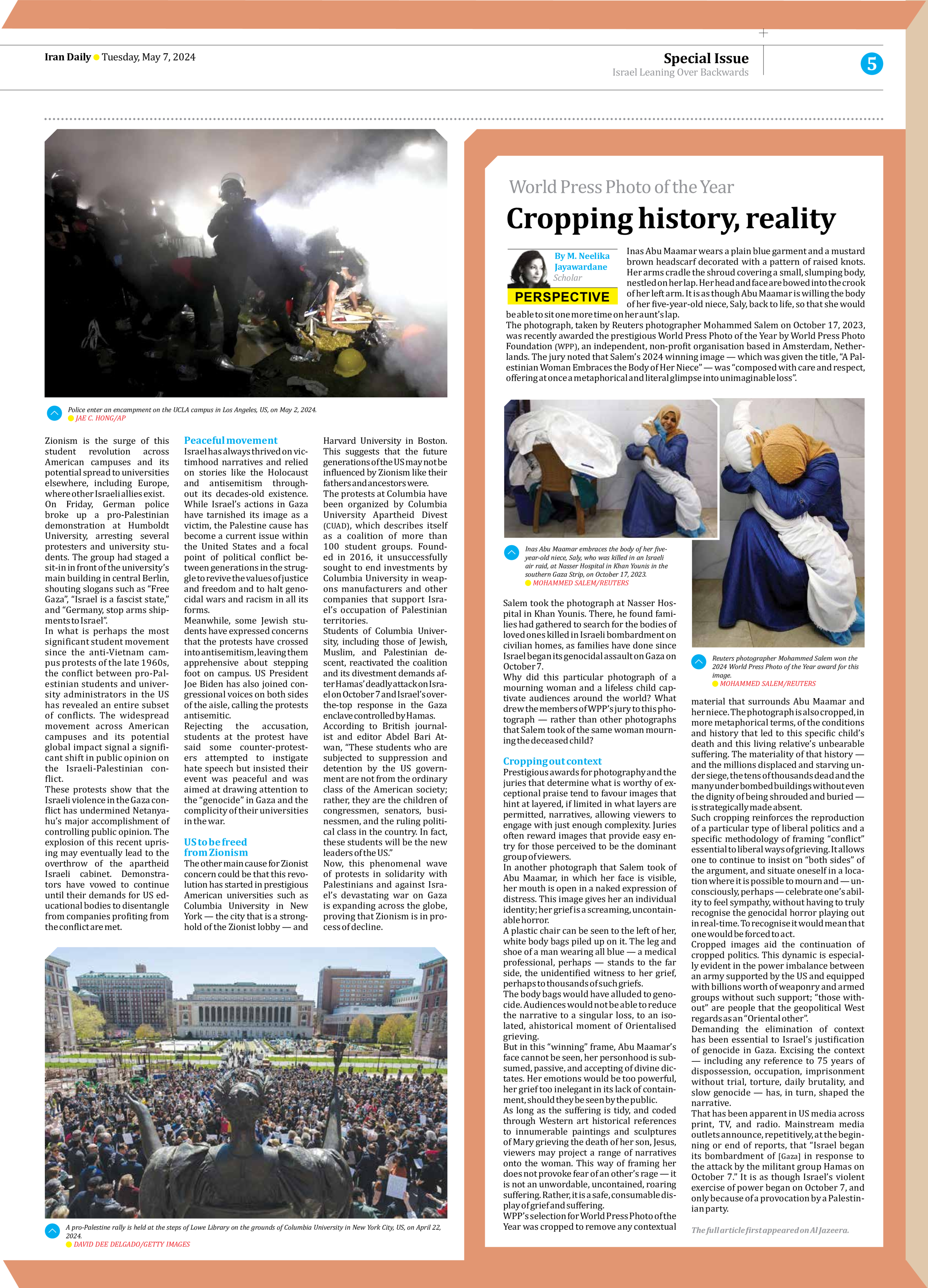
World Press Photo of the Year
Cropping history, reality
By M. Neelika Jayawardane
Inas Abu Maamar wears a plain blue garment and a mustard brown headscarf decorated with a pattern of raised knots. Her arms cradle the shroud covering a small, slumping body, nestled on her lap. Her head and face are bowed into the crook of her left arm. It is as though Abu Maamar is willing the body of her five-year-old niece, Saly, back to life, so that she would be able to sit one more time on her aunt’s lap.
The photograph, taken by Reuters photographer Mohammed Salem on October 17, 2023, was recently awarded the prestigious World Press Photo of the Year by World Press Photo Foundation (WPP), an independent, non-profit organisation based in Amsterdam, Netherlands. The jury noted that Salem’s 2024 winning image — which was given the title, “A Palestinian Woman Embraces the Body of Her Niece” — was “composed with care and respect, offering at once a metaphorical and literal glimpse into unimaginable loss”.
Salem took the photograph at Nasser Hospital in Khan Younis. There, he found families had gathered to search for the bodies of loved ones killed in Israeli bombardment on civilian homes, as families have done since Israel began its genocidal assault on Gaza on October 7.
Why did this particular photograph of a mourning woman and a lifeless child captivate audiences around the world? What drew the members of WPP’s jury to this photograph — rather than other photographs that Salem took of the same woman mourning the deceased child?
Cropping out context
Prestigious awards for photography and the juries that determine what is worthy of exceptional praise tend to favour images that hint at layered, if limited in what layers are permitted, narratives, allowing viewers to engage with just enough complexity. Juries often reward images that provide easy entry for those perceived to be the dominant group of viewers.
In another photograph that Salem took of Abu Maamar, in which her face is visible, her mouth is open in a naked expression of distress. This image gives her an individual identity; her grief is a screaming, uncontainable horror.
A plastic chair can be seen to the left of her, white body bags piled up on it. The leg and shoe of a man wearing all blue — a medical professional, perhaps — stands to the far side, the unidentified witness to her grief, perhaps to thousands of such griefs.
The body bags would have alluded to genocide. Audiences would not be able to reduce the narrative to a singular loss, to an isolated, ahistorical moment of Orientalised grieving.
But in this “winning” frame, Abu Maamar’s face cannot be seen, her personhood is subsumed, passive, and accepting of divine dictates. Her emotions would be too powerful, her grief too inelegant in its lack of containment, should they be seen by the public.
As long as the suffering is tidy, and coded through Western art historical references to innumerable paintings and sculptures of Mary grieving the death of her son, Jesus, viewers may project a range of narratives onto the woman. This way of framing her does not provoke fear of an other’s rage — it is not an unwordable, uncontained, roaring suffering. Rather, it is a safe, consumable display of grief and suffering.
WPP’s selection for World Press Photo of the Year was cropped to remove any contextual material that surrounds Abu Maamar and her niece. The photograph is also cropped, in more metaphorical terms, of the conditions and history that led to this specific child’s death and this living relative’s unbearable suffering. The materiality of that history — and the millions displaced and starving under siege, the tens of thousands dead and the many under bombed buildings without even the dignity of being shrouded and buried — is strategically made absent.
Such cropping reinforces the reproduction of a particular type of liberal politics and a specific methodology of framing “conflict” essential to liberal ways of grieving. It allows one to continue to insist on “both sides” of the argument, and situate oneself in a location where it is possible to mourn and — unconsciously, perhaps — celebrate one’s ability to feel sympathy, without having to truly recognise the genocidal horror playing out in real-time. To recognise it would mean that one would be forced to act.
Cropped images aid the continuation of cropped politics. This dynamic is especially evident in the power imbalance between an army supported by the US and equipped with billions worth of weaponry and armed groups without such support; “those without” are people that the geopolitical West regards as an “Oriental other”.
Demanding the elimination of context has been essential to Israel’s justification of genocide in Gaza. Excising the context — including any reference to 75 years of dispossession, occupation, imprisonment without trial, torture, daily brutality, and slow genocide — has, in turn, shaped the narrative.
That has been apparent in US media across print, TV, and radio. Mainstream media outlets announce, repetitively, at the beginning or end of reports, that “Israel began its bombardment of [Gaza] in response to the attack by the militant group Hamas on October 7.” It is as though Israel’s violent exercise of power began on October 7, and only because of a provocation by a Palestinian party.
The full article first appeared on Al Jazeera.







